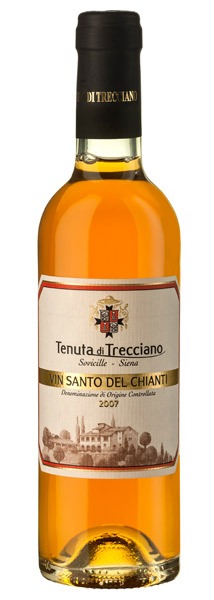Generally we consider the Vin Santo (or Vinsanto) a raisin wine made from dried grapes, which is traditionally produced in Tuscany and Umbria, but also in Emilia-Romagna, Veneto and Trentino. As it often happens in Italy, the variety and diversity of wines is very high in every region and even inside the same region there are often many production subareas.
This is exactly the case of the Vin Santo from Chianti, which is subdivided in Classic, Colli Aretini, Colli Fiorentini, Colli Senesi, Colline Pisane, Montalbano, Montespertoli, Rufina.

Where does the name “Vin Santo” come from?
Let’s take a step backward … What is the origin of this name and, in particular, of the word “santo”? There are different hypothesis; the most common one traces the name to an anecdote: during the Florence ecumenical council in 1439, the Byzantine Cardinal Bessarione tasted a local liquor wine and exclaimed: «This is the wine from Xàntos!», referring to a very well known wine that was produced in Greece; then the term had been probably Italianized as “santo”. Other interpretations link up the term with the use of a liquor wine for the Eucharist during the Mass, or to the fact that grapes are dried until the Holy Week.
How is the Vin Santo from Chianti produced?
Apart from its etymology it is very interesting to know the special way in which Vinsanto is produced, in particular we are talking about the one from Chianti. First of all the origins of grapes, that are mostly wite grapes, Tuscan Trebbiano and Malvasia. However, there is also a version produced with red grapes (Sangiovese), which is called “Vinsanto occhio di pernice”(soft corn).
These grapes are carefully selected during the harvest period and then taken to a room (appassitoio – wilting room) that has to be well-aired in order to limit the mold formation. Here grapes are placed on reeds (“cannicci”), mats of reeds, or are hung on hooks on frames for wilting, that usually goes from December to March. At the end of the wilting process, only the healthiest grapes are pressed and the must is fermented in special wooden kegs (“caratelli“, small casks with a capacity between 50 and 200 litres), that are stored in the vinsantaia (the aging cellar), where it will stay for a minimum aging of 3 years.
The pairings of Vin Santo
Like all raisin wines, Vin Santo is an excellent dessert wine, that accompanies dry pastries in a fabulous way (in particular the cantuccini or the Sienese ricciarelli). Anyway, in its driest versions, it can be tasted even before the dessert, paring it with liver croutons, Tuscan cold cuts, seasoned and blue cheeses.
You can see more details in the technical sheet of Vin Santo del Chianti DOC produced by Tenuta di Trecciano.
We are waiting for you to taste it together!








